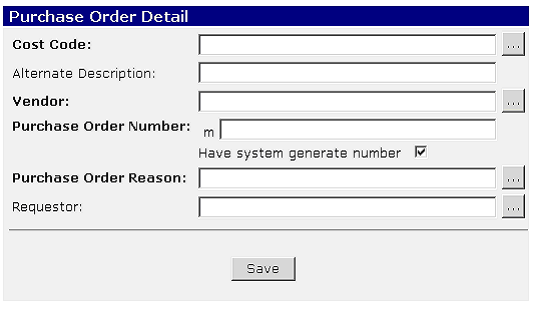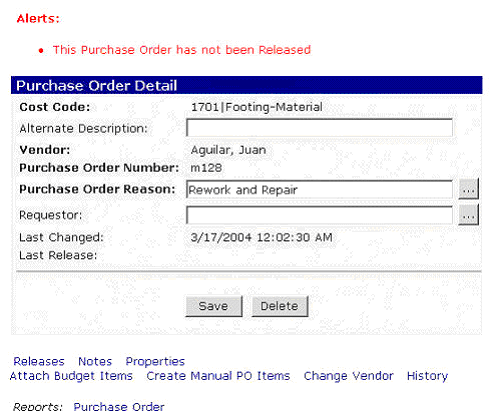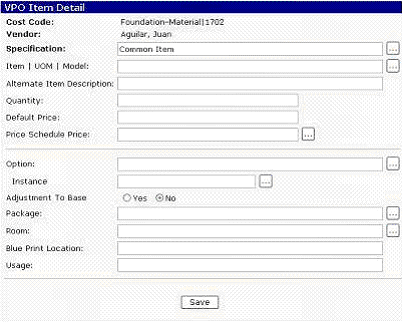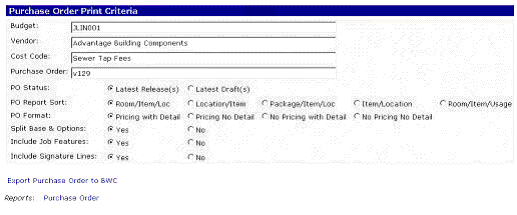
The manual purchase order (VPO) functionality creates a manual purchase order that can be used for standard manually created, non-variance purchase orders. The cost for items included on a manual purchase order are included in the Job Budget totals sent to the accounting tool.
Manual purchase orders can be built/managed from inside a budget, or from the main menu.
To build a manual purchase order from inside a budget:
1. Choose Manual POs from the Budget Detail screen.
2. Choose Add Purchase Order from the link at the bottom of the screen.

3. See steps below to enter Purchase Order Detail information.

To build a manual purchase order from the main menu, complete the following steps:
1. Choose Manual POs from the main menu screen.
2. Choose Add Manual PO from the link at the bottom of the screen.

3. See below for steps to enter Purchase Order Detail information.

|
Note |
|
The steps below apply to both budget and main menu manual Purchase Order Detail screens.
|
Step 1 |
Click the gray pick list button and add the Cost Code. |
|
Step 2 |
Enter an Alternative Description if the standard cost code description is not appropriate for the item being purchased. (Optional) |
|
Step 3 |
Click the gray pick list button and add the Vendor. |
|
Step 4 |
The box is checked by default to allow the system to generate the Variance Purchase Order Number which insures that it will be a unique number never before used on a purchase order. Enter any character in the purchase order number field to remove the check from the system generated box. |
|
Step 5 |
Click the gray pick list button and add the Purchase Order Reason. |
|
Step 6 |
Click the gray pick list button and add the Requester Name. This list of names is created in the Support Table for Personnel. |
|
Step 7 |
Click Save. |
9. Click Manual POs on the navigation string and select the purchase order record from the browser view.


9. Additional information is displayed on the Purchase Order Detail screen. The Last Changed and Last Release are populated automatically based on changes and releases of the Manual PO.
10. Click OK to enter the approval date and lock the purchase order.
11. Click Cancel to prevent the save.
Using Existing Budget Items
Existing items are those items added in the budget layer takeoffs after the original purchase orders were created or those items with default pricing. If the vendor is the primary vendor and has pricing, the pricing can be set by using Price Schedule Price on the item detail screen when adding the item or by using Set Pricing for non-priced items on the budget detail screen or if the vendor has no pricing by adding a default price for the takeoff item. If the vendor is not the primary vendor but has pricing for the item, the pricing can be set using Price Schedule Price on the item detail screen when adding the item or if the vendor has no pricing by adding a default price for the takeoff item. Set Pricing from the main menu can only be used for primary vendors for the job. To create a PO using an existing item(s), complete the following steps:
Select the Attach Budget Items link and the following screen will display

2. Click the item(s) on the left side and add to the right side to attach them to the purchase order.
3. Click the PO number in the navigation string and choose the Releases link.
4. Choose Add Purchase Order Release.

5. Enter the Purchase Order Release Detail information by following the steps below.

|
Step 1 |
Enter text in Label for Release. (Optional) |
|
Step 2 |
Click Save. |
Adding the Item at the Manual PO
Items are sometimes needed for a purchase order that have not been added to the budget takeoff. Occasionally these items do not even exist in the Master Item List.
To create a purchase order with items not added to the budget takeoff, complete the following steps:
1. Select the Create PO Items link.
2. Click Add PO Items.

3. Enter the VPO Item Detail information by following the steps below.

|
Step 1 |
Click the gray pick list button and select the specification.
Hint: Typically the “All” or “Base House” type standard feature is used.
|
|
Step 2 |
Click the gray pick list button and select the item if it exists in the Master Item List. If the item is priced in contract for the vendor being issued the VPO, the item will also be displayed for selection with that pricing. If the vendor has multiple contracts, the item will appear with each of the prices. In this case, choose the appropriate contract price for the VPO, and the price will automatically be added in the Price Schedule Price field. If the item does not exist in the Master Item List, add a text description in the Alternative Item Description field. This description will be printed on the VPO but will not be added to the Master Item List. If the item is one that will be used multiple times, add it to the Master Item List. |
|
Step 3 |
Enter Quantity. (Optional if a default price is being used.) |
|
Step 4 |
Enter the Default Price for those items without vendor pricing or when the price for the VPO item is different than the vendor’s standard bid price for the item. Hint: If the pricing for the item on VPO is different than the standard pricing for the item, a default price can be used for the total amount of the item. Quantity is informational only when default pricing is used. Quantity is not be used as a factor for calculating total pricing. Example: Quantity = 100, Default Price = $5, the total dollar amount for the item will be $5. If the unit price is $5, the default price should be $500. Note: No taxes will be calculated on a default price even if the item is marked taxable. Taxes must be included in the default price. |
|
Step 5 |
Click the gray pick list button for Price Schedule Price if the vendor pricing that was added in Step 4 was from the wrong contract and needs to be changed. |
|
Step 6 |
Click the gray pick list button for Option and select the option description. (Optional) |
|
Step 7 |
Click the gray pick list button for Instance and select the option instance that applies. (Required only if an option is chosen in Step 8.) |
|
Step 8 |
Click Yes if the item is an adjustment to the base house takeoff or No if it is not. Default is No. |
|
Step 9 |
Click the gray pick list button for Package and select a package. (Optional) |
|
Step 10 |
Click the gray pick list button for Room and select a room. (Optional) |
|
Step 11 |
Enter Blueprint Location. (Optional) |
|
Step 12 |
Enter Usage. (Optional) |
|
Step 13 |
Click Save. |
4. Choose Add Purchase Order Release.

5. Enter the Purchase Order Release Detail by following the steps below.

|
Step 1 |
Enter text in Label for Release. (Optional) |
|
Step 2 |
Click Save. |
PO Notes
Notes can be added to the PO for informational purposes. See Lesson 3 for complete instructions on adding notes.
Adding Properties to POs
Instructions for adding properties can be found in this lesion under Adding Properties to Budgets.
POs – Printing, Sending to BWC, Using an Electronic Purchase Order (EPO)
From the PO detail screen, print a purchase order, send it to BuildingWithCentex.com, or send it as an EPO.
1. Choose the Purchase Order Link at the bottom of the screen.
2. Enter the Purchase Order Print Criteria by following the steps below.

3. The budget, vendor, cost code, and purchase order fields will be pre-populated.
4. Set the Purchase Order Status for Latest Release or Latest Draft. If the VPO has not been released, choosing latest release will result in a blank report.
5. Choose the PO Report Sort.
6. Choose the PO Format.
7. Choose Yes to split base and options, No to report them together.
8. Choose Yes to include job features, No to exclude.
9. Choose Yes to include approval signature lines, No to exclude.
10. Choose the Export Purchase Order to BWC link to send the purchase order to BuildingWithCentex.com, choose EPO to send an electronic purchase order, or choose Purchase Order to display the purchase order that can be printed.